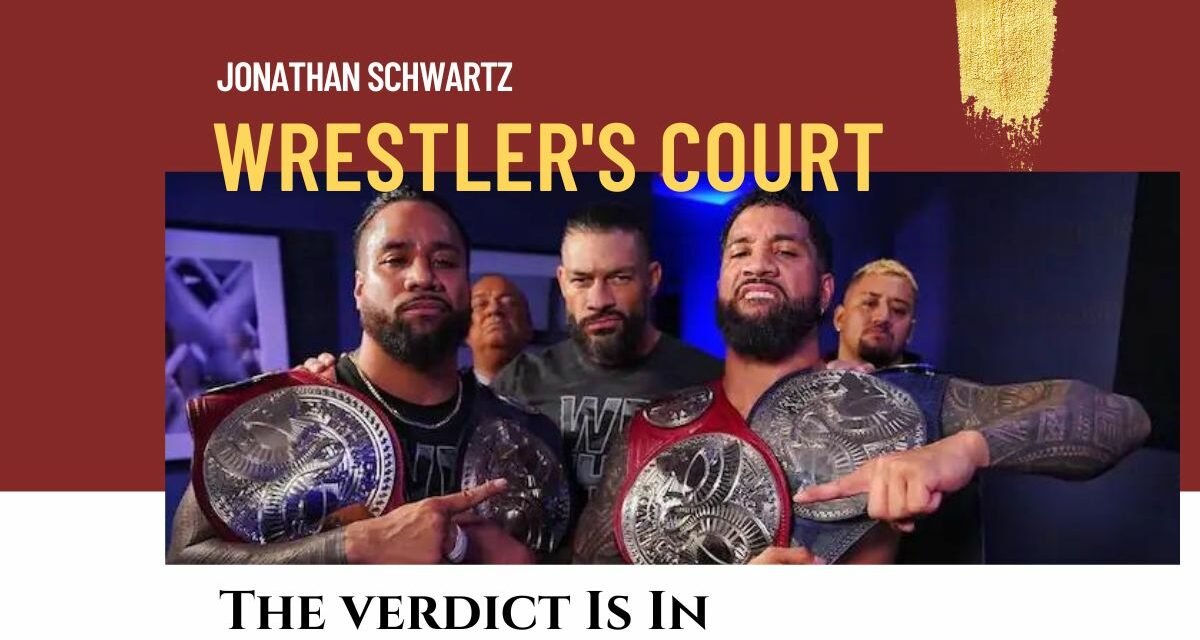I imagine that many of us born post-television came to our pro wrestling fandom in a similar way. As kids, left with a responsible adult on a lazy afternoon or evening, set in front of the idiot box to watch the latest episode of our local (or national) promotion’s show. Routine for the adults in the room but new to us. Exactly what we watched might differ. Maybe your first memory is Antonino Rocca or Bruno Sammartino or Ric Flair or Jerry Lawler or Hulk Hogan. If said memory is John Cena then I can’t see you.
Part of what drew us in is the impression it made on the adult in our lives. Often a person we love and admire. We feel in our guts that this show, with its acrobatics and feats of strength and drama and colorful characters, is a way for us to connect with our fellow viewers.
In my case, that person was (and is) my Dad.
Wrestling fandom is often generational. In my case fostered by successive Schwartz fathers (and carried on by me with my own children) and tolerated with gentle good humor and occasional disbelief by Moms.
The wrestling business is generational as well.
The recent deaths of Lanny Poffo and Jerry Jarrett show how much of the ‘sport’ we love is carried by the same few families: how they ebb and flow over time, the role that ownership may play in giving some wrestlers a leg up, and the unpredictability that comes with each generation.
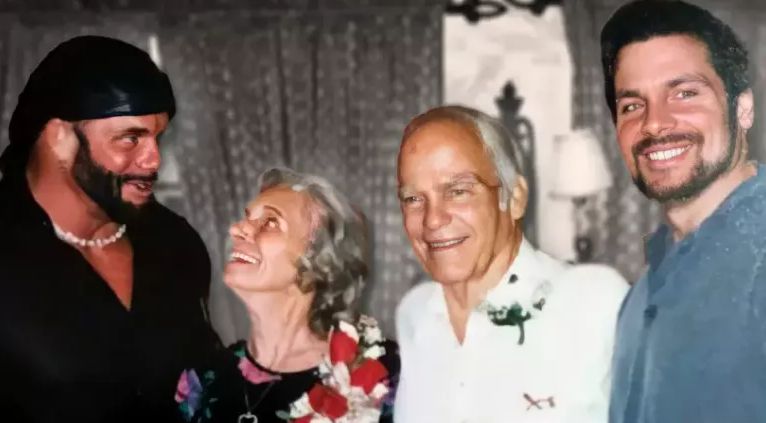
Randy, Judy, Angelo and Lanny Poffo. Courtesy Lanny Poffo
We can come up with examples where children’s accomplishments eclipse or are overshadowed by their famous parents. We can think of cases where children desperately cling to their parent’s legacies despite their own shortcomings. Pro wrestling has its fair share of “nepo babies” and others whose careers are built on attempts to distance themselves from those legacies. There seems to be a lack of correlation between one generation’s status in the business and the next, talent notwithstanding.
I’ll pause to note that pro wrestling’s dynasties could be a book unto itself. A full discussion of wrestling’s bloodlines is well beyond the scope of this column. In Canada alone, we have the Harts out west, the Vachons and Rougeaus duelling it out in Quebec, and the Cormiers and Duprees in the Maritimes. Each of these families produced generations of successful wrestlers. Puerto Rico has the Colons. Mexico has more than I can name, clouded by the facts that many luchadores remain anonymous (all the more impressive given how nosy social media can be), masked gimmicks can be swapped from person to person and there seems to be little relation between the Juniors and El Hijo Dels and actual consanguinity. Sometimes they overlap, as with the Guerreros and Mysterios (WWE still markets I’m Your Papi t-shirts and Dominik has grown a sweet Eddie-worthy mullet). In my research for this column, I found surprisingly few Japanese wrestling families-there seems to be more continuity on the promoting side than in-ring.
I draw a distinction here between actual families and the kayfabe clans that make up so much of wrestling history. I alluded to this in my last column; the practice of extending a popular wrestler’s brand by gifting him or her with an assortment of relatives.
The Wrestler Executive Producer Evan Ginzburg often cites the Valiant Brothers as one of his favorite tag teams. They may be, but neither Johnny, Jerry nor Jimmy were actually related. The Golden Grahams branched out from charismatic originator Dr. Jerry to include ‘brothers’ Eddie, Crazy Luke and Superstar Billy. Each addition to the family would capitalize on Jerry’s infamy and take it in his own direction. Eddie would become the main attraction and eventually own the Florida promotion. Luke would have his own run with the WWWF tag team titles and work across the country. Billy is probably the best-known Graham and the last member of the group still standing despite his recent ill health. Billy would capture the WWWF title from Bruno Sammartino and hold it for almost a year until losing it to Bob Backlund — a move that was booked by Vince McMahon Sr. from the start, but which seems to have hurt the Superstar to his core, leading to long periods of estrangement from the business and a strong critical internet presence to this day. The Andersons tore through Middle America and the US South first Gene, then Lars and later Ole and Arn formed a series of compelling heel teams.
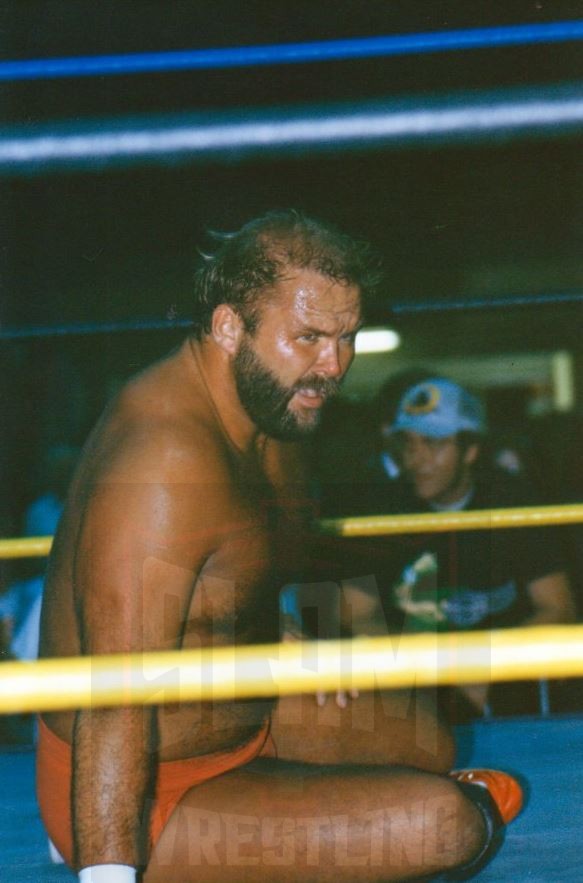
Arn Anderson at Toronto’s CNE Coliseum for a NWA show on June 27, 1990. Photo by Cliff Ketcheson
The Graham and Anderson ‘family units’ would gain a slight measure of legitimacy as the originals had children who entered the business. Eddie Graham’s son Mike was a talented Junior Heavyweight at a time when wrestlers grew to gigantic proportions. Luke also allegedly had a son who wrestled as Jr… but I’m not sure whether he was actually OG Luke’s son. Gene’s son Brad had a run in WCW although Ole refused to let him wrestle under the family name. If you remember a pink and black masked enhancement talent from Europe named Zan Panzer, he was an Anderson. Ole’s own son Bryant had a brief run with WCW in the early 1990s. He’s now a lawyer, which may be the ultimate heel turn. Today Arn’s son Brock is trying to make an impact on AEW programming, sometimes alongside Brian Pillman, Jr.… It’s probably too early to judge how well they carry their family legacies-whether real or invented.
Perhaps the most egregious example of wrestling nepotism not involving people named Vince, Shane or Stephanie was Nick and George Gulas. Nick was not a wrestler, although he did work as a manager in the southern U.S. He was instrumental in developing Memphis and Nashville, Tennessee as wrestling hotbeds. He is credited with helping start the careers of wrestlers including Tojo Yamamoto, Jackie Fargo and Jerry Lawler. He was also infamous for pushing his only son, George, as a top name despite George’s utter lack of talent. George wrestled for about eight years, including as part of a team with Bobby Eaton — a shrewd pick that would have capitalized on Eaton’s stellar ring work and George’s charisma; if only George had charisma. Pick up a wrestler’s autobiography and if said wrestler was active in the 1970s, George’s name will come up as an example of how to kill a territory. Sofia Coppola may have hurt the Godfather franchise, but she has since made up for it as a director in her own right. I don’t think George ever found his niche.
Clearly, pro wrestling has long been a family affair. Until the WWF’s national expansion, pro wrestling territories were relatively small businesses reliant on live gates and carefully managed costs to draw profits. Bringing in younger family members helped with the latter. I suspect that most families periodically outsource unpaid labor to their children depending on age and ability. Some kids proofread their parents’ reports. Others wait tables. Some affix straps to watches and box them for presentation. In wrestling, they may start out as ticket-takers or referees.
Where marquee wrestlers own a piece of the office, keeping it in the family makes sense. Hulk Hogan claims that he was denied the AWA World Heavyweight Championship despite the massive popularity of Hulkamania because he refused to marry promoter Verne Gagne’s daughter (an alternate version of history suggests that Gagne was hesitant to run with Hogan out of his conviction that only ‘legitimate’ promotion’s face). Gagne’s own son, Greg, was a capable wrestler but lacked the build or charisma to carry the promotion despite Verne’s best efforts. He was still featured prominently and secondary titles were invented to keep him relevant. Larry Zbyszko would later marry said daughter, Donna, and he wound up carrying the AWA strap through its dying days.
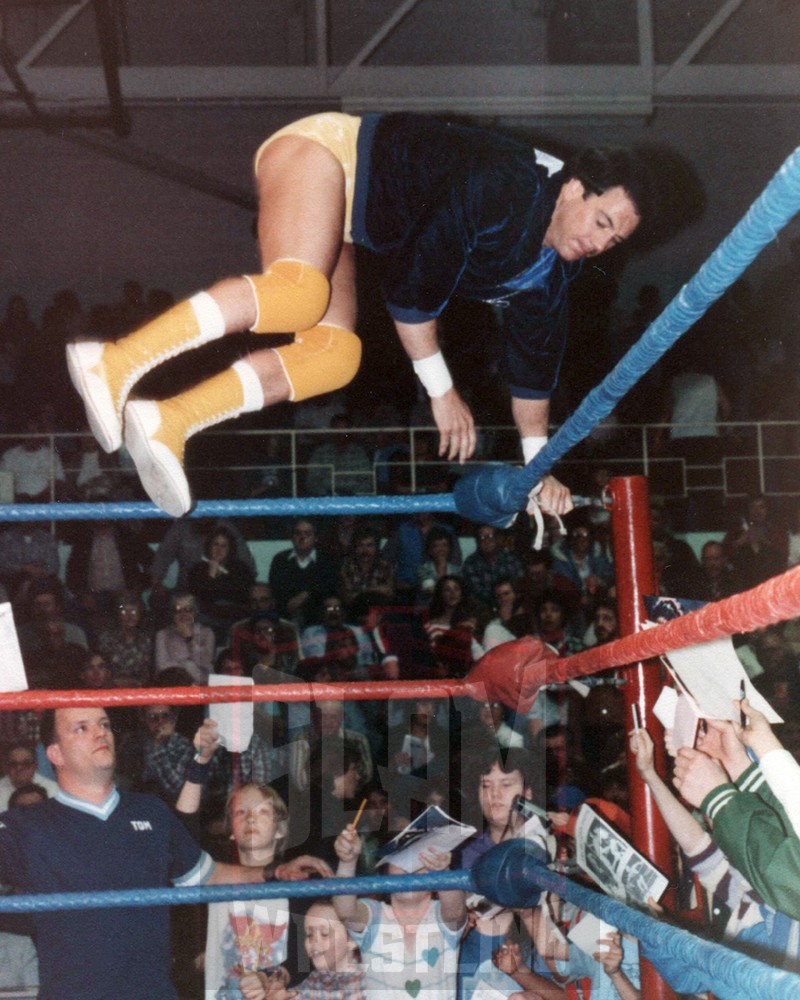
Greg Gagne hops in the ring for AWA action. Photo by Joyce Paustian
Veteran wrestling commentator Christopher Cruise has opined that the charisma needed to succeed in wrestling often skips a generation. Cruise is an admitted Bruno Sammartino fan. He acknowledges that while Bruno was captivating, his son David failed to move the needle even with the rising tide of WWF’s national expansion. Bruno and David would fall out over the latter’s career and remain estranged for the rest of Bruno’s life. Canada’s Greatest Athlete Gene Kiniski enjoyed a four-year NWA title reign as a gruff heel. His sons Nick and Kelly barely made a splash in the AWA. Hulk Hogan’s son Nick kinda sorta started training to be a wrestler but decided driving race cars was a better career move. Nope.
You can argue about wrestlers with longer careers. Johnny Valentine was a main eventer across the globe. His son Greg (sometimes billed as his brother, sometimes as a member of the fictitious Fargo family, most often as the Hammer) had his share of main events, too, and was one of Bob Backlund’s main opponents before holding a solid mid-card spot under Vince McMahon Jr. as a tag team and intercontinental champion. Greg worked a slow, deliberate style and while he could talk, relied heavily on managers to get his message across. Of Stu Hart’s 12 children, two would make it to wrestling’s biggest stage while the rest would find work in various Stampede Wrestling incarnations. Bret and Owen are best known for their ring work, not their interview skills (Bret himself acknowledges this fact. And he’s still my favorite wrestler, so there-internet!).
I’m not sure I agree with Cruise’s thesis. I think in many cases charisma is situational. With exceptions, today’s wrestlers don’t have the benefit of the territory system to work on their acts under a degree of anonymity before hitting the international stage. Until recently the main pipeline for stars in the US and Canada was WWE’s own developmental system, which could freight second or third-generation talent with unreasonable expectations.
Ted DiBiase and Curt Hennig were both second-generation stars in their own rights. We all know DiBiase Sr. as the Million Dollar Man, a wickedly charismatic heel who debuted that character in Vince McMahon’s WWF in 1987. But DiBiase’s career began in the Mid-South Territory in 1974. He had stints in Japan and came to prominence in Bill Watts’ Universal Wrestling Federation through the mid-1980s when he was cherry-picked by the WWF to play his most famous role. Along the way, he had a brief, bland stint in the WWWF where he was awarded the North American championship and promptly dropped it to Pat Patterson to create the Intercontinental Championship. Curt Hennig had a shorter path to perfection. He debuted in 1980 and his first WWF stint was no more notable than DiBiase’s. Between 1981 and 1983 he worked in New York mostly as an enhancement talent, often alongside fellow second-generation wrestler Eddie Gilbert. Hennig’s journey took him to the Pacific Northwest territory and back to a declining AWA where his world title reign was a bright spot. He returned to the WWE in 1988 as a ring veteran-even still the Mr. Perfect gimmick was a toss-up between him and Terry Taylor. The loser of that decision would become the Red Rooster. There but for the grace of Vince…
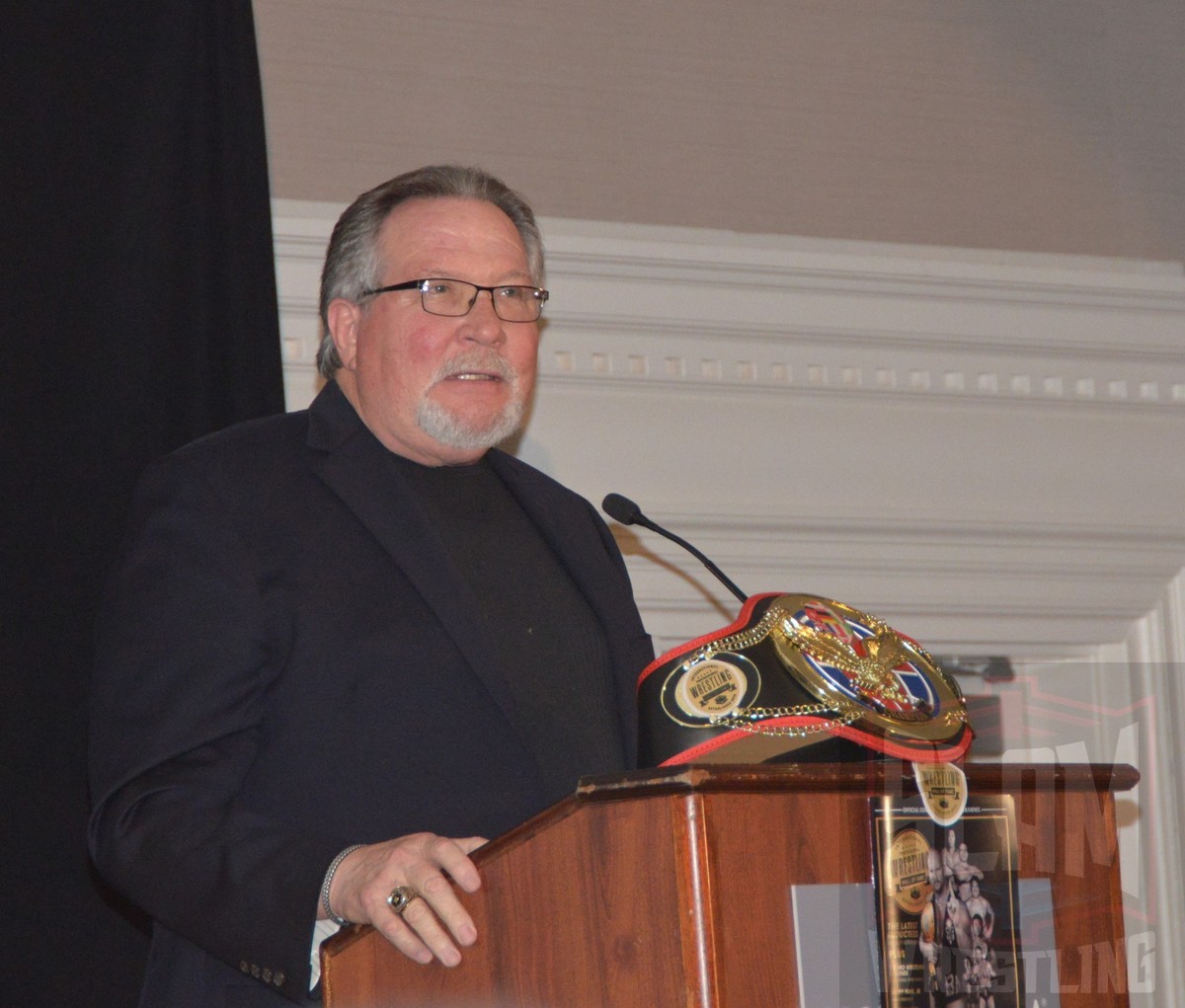
Ted DiBiase at the International Professional Wrestling Hall of Fame induction banquet on Saturday, August 27, 2022, at the Desmond Hotel, in Albany, NY. Photo by Wayne Palmer
All of which is to say that as second-generation talents, the Million Dollar Man and Mr. Perfect had the chance to learn in front of audiences across the US and abroad before they became the performers we know today. Their early incarnations were far from charismatic. Contrast this with Ted DiBiase Jr. who debuted in 2006 and by the next year was part of WWE’s farm system in Florida Championship Wrestling. DiBiase Jr. would join the main roster by the following year as part of Randy Orton’s Legacy stable, alongside Cody Rhodes (whose progress was similarly rushed and who only now, after several years away from WWE is getting a suitable run). Curt Hennig’s son Joe had a more confusing WWE stint. Despite being a very strong technician in-ring and his own third-generation pedigree, WWE eschewed the Hennig name in favor of “Michael McGillicutty” and later “Curtis Axel” — the latter an intended tribute to Hennig’s father and grandfather, but one that missed the mark. Hennig would debut in 2007 in Harley Race’s World League Wrestling and be called up to the WWE main roster by 2010 as a replacement Nexus member alongside a pre-Bray Wyatt Husky Harris.
Ted DiBiase Jr. and Joe Hennig were very good wrestlers who were allegedly bland. I would argue that neither man ever had the opportunity to develop their own charisma or character. Given time to mature as performers outside the spotlight and away from the expectations imposed by their parents’ last names, I think both men could have gone a lot farther. The same goes for talents like Bo Dallas (who may or may not currently be yukking it up as Uncle Howdy alongside his brother Bray) and Harry Smith (who has been successful in Japan and in Major League Wrestling but has yet to experience a significant solo run stateside). Stan Stasiak’s son Shawn is largely retired but still impossibly dreams of a father/son WWE title run. Vader’s son, Jake Carter and Repo Man’s son Dakota Darsow, never made it out of developmental. In AEW the jury is out on Austin and Colton Gunn — the Ass Boys — whose first tag title reign is mired in storyline daddy issues. Kevin Von Erich’s sons Ross and Marshall are rumored to be finishing up with Major League Wrestling and might soon appear in AEW or WWE. D-Von Dudley’s twin sons have popped up on Impact with little…er…impact. Larry Zbyszko’s son Tim wrestles on the independent scene as “The Living Legacy” or “Ripper” Zbyszko, Rock ’n’ Roll Express member Ricky Morton’s son Kerry is getting a push in Billy Corgan’s NWA alongside lifelong jobber Joe Cazana’s son AJ.
The current NXT crop boasts its own set of next-generation stars. Twenty years ago their parents could be found anywhere from the opening match to the main event: The NXT Champion is Bron Breakker. Despite his ring name, he is openly acknowledged as Rick Steiner’s son and Big Poppa Pump’s nephew. Santino Marella’s daughter Bianca Carelli now goes by Arianna Grace. John Cena’s former sidekick Bull Buchanan’s son Benjamin is part of a country boy tag team as Brooks Jensen. Jabroni Flex Kavana from Memphis also has a daughter popping up in Joe Gacy’s creepy Schism stable. I wonder if she’ll go on to similar obscurity.
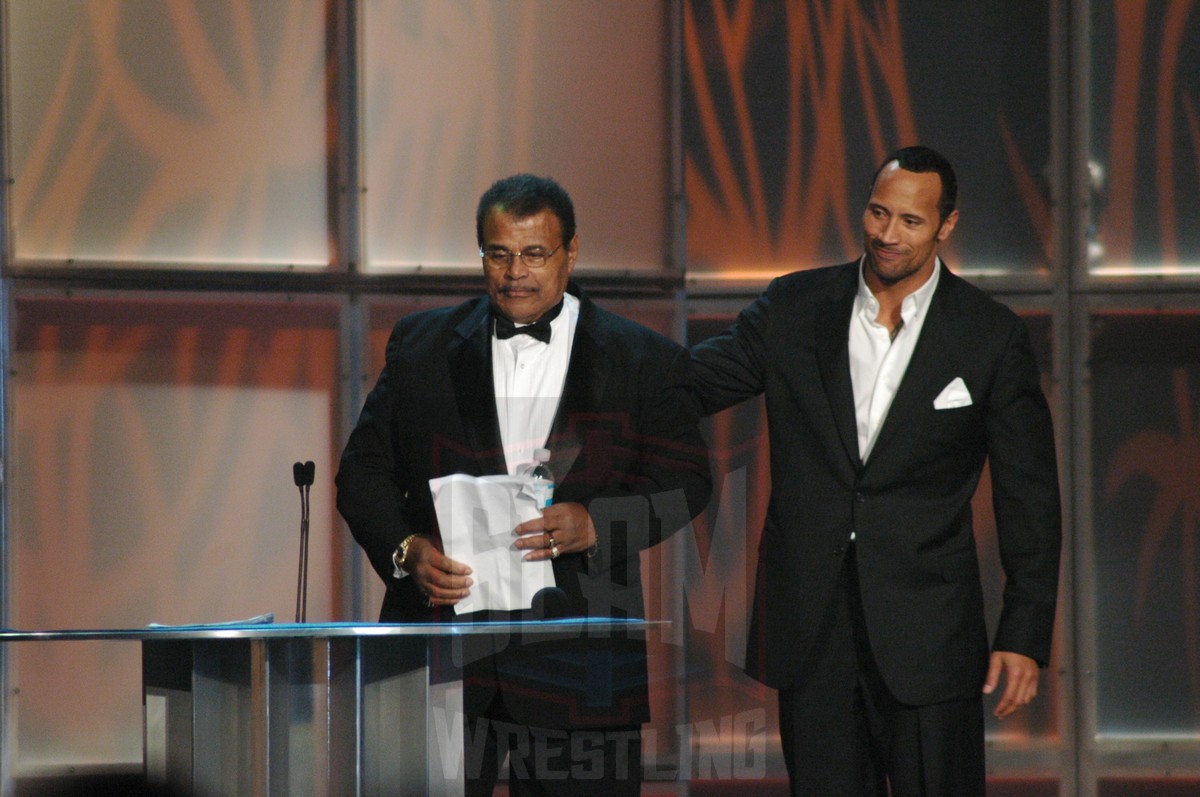
Rocky Johnson and his son, The Rock. Credit: WWE
My personal favorite of the lot is Von Wagner, who’s still finding his feet as a monster heel managed by former Jersey Shore resident Robert Stone. Wagner’s dad was another late-era AWA performer, Wayne “The Train” Bloom. Here my bias comes into play: I think that Bloom and his partner Mike Enos were great as AWA tag team champions the Destruction Crew. Their tenure as the Beverley Brothers in WWE was a missed opportunity, especially under the tutelage of Poffo in his Genius persona (if I don’t mention John Tolos’ brief run as “Coach” Evan and Dr. Mike Lano he will never forgive me). I even popped for their few matches in full Destruction Crew regalia plus masks as the Minnesota Wrecking Crew II for WCW (turns out this happened because while the AWA was all but dead they were still burning off TV shows, and the Crew couldn’t show their faces without getting into legal trouble).
Sidebar: I yearn for the Minnesota Wrecking Crew III — Wagner, plus fellow Minnesotans/current channel changers Rick Boogs and Madcap Moss. Let them grind their opponents with endless hammerlocks and they’re a license to print money.
But I digress.
For all of the examples of second and third-generation wrestlers who did not live up to their parents’ standards, there are plenty who did, and who still do. Talent and hustle and opportunity seem to be randomly distributed.
Succession in wrestling now crosses gender lines in a way that would have been unthinkable when I was a kid. Charlotte Flair has been the linchpin of WWE’s women’s division for the better part of a decade, succeeding where her older half-brother David (who was similarly undertrained and over-pushed in WCW’s end times) failed. Natalya Neidhart has been the anchor of the women’s division since before the Revolution, turning in solid matches and making stars out of fitness models and former UFC fighters whom she could likely thrash. Natalya has survived a stream of bad gimmicks and weak pushes, but truly talented women wrestlers have long struggled to find sustained success. Carmella’s father Paul Van Dale worked enhancement matches for the WWF, though I don’t recall seeing him on TV. Saraya (formerly Paige) comes from a nearly Anoa’ian family of pro wrestlers. Her career has also been hurt by a combination of out-of-ring issues and injuries, but hopefully, she is back on track and fully healthy in AEW. Outside of WWE, Tessa Blanchard was primed for a successful career following her recent Impact Wrestling stint but seems to be taking a step away from the business following controversy and some reputational damage.
Before Natalya, there was Luna Vachon (Paul’s stepdaughter) and Rockin’ Robin — part of a family that includes Jake Roberts and Sam Houston… I struggled with including them in this list. While most of the families I’ve mentioned here have some degree of dysfunction (I left the Harts mostly out of this column because there have already been several books written by and about them) there are also cases like the Smiths, where the children grew up allegedly facing terror and abuse at the hands of their father, Grizzly Smith. The same goes for the Snukas, Jimmy’s own autobiography acknowledges his absence from his children’s lives, coupled with a history of open substance abuse and domestic violence. The Rock emphasizes his Samoan heritage and has spoken at length about his challenging relationship with his own father, former WWF tag team champion Rocky Johnson. Slam Wrestling’s own Greg Oliver has covered the elder Johnson’s record as a father at length. While Dwayne may have had issues with his dad, he was the kid who stayed in the picture. Per Mr. Oliver’s article, Rocky fathered children across Canada and allegedly ignored them all.
Former wrestler and promoter Fritz Von Erich elevated his territory to national attention in part by pushing his sons as standard-holders and champions. Older sons David, Kerry and Kevin were rock stars in Dallas and had become in-demand performers throughout the NWA. Their fame came at a horrible price that no sane parent would ever dream of paying. The three brothers, along with younger siblings Mike and Chris, developed significant substance abuse issues and in some cases ran afoul of the law.
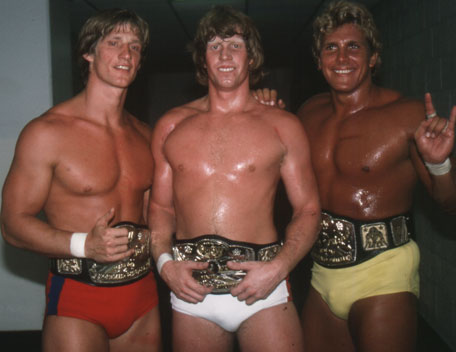
Kevin, Mike and Lance Von Erich. Photo credit: Mike Lano wrealano@aol.com
David (who was rumored to have been in line for an NWA title run) would pass away from what was portrayed as an intestinal issue in a Japanese hotel room. Other wrestlers have since claimed this was in fact an overdose death, and they helped clean the scene before the ambulance and police were called.
Kerry would develop a serious substance abuse issue and facing criminal charges, took his own life in his early 30s.
Younger son Mike was never cut out for the wrestling business but pushed his body past its limits under pressure from his father. He would kill himself as well as would youngest son Chris — the latter despondent that he was ‘too small’ to make it in the family business.
In the middle of these horrors, Fritz tried to keep his promotion afloat however he could, going so far as to recruit a local gym-goer to play a Con Erich: “Lance”, a kayfabe cousin. Fans rejected this move, which has since been seen as a step in Fritz’s decline. History has judged Fritz harshly. He is said to have relentlessly pressured his sons into their roles as wrestlers, pushing them to achieve heights he never reached. Fritz’s commitment to kayfabe and the expense of his real family has been covered by many; a movie is in the works. There might be a marginally sympathetic view here; before Fritz tried to turn his children into a dynasty, he was part of a ‘Nazi’ tag team with ‘brother’ Waldo — a Canadian wrestler named Walter Sieber (Waldo and Fritz would be paired together by Stu Hart in his Calgary territory, speaking of family matters). Waldo would go on to be an early and prolific opponent of Bruno Sammartino; fans suggest that he may have been Sammartino’s most frequent challenger. Lance would be billed as Waldo’s son.
Up in the AWA, Verne Gagne was notably cautious about appointing his champions — keeping a stranglehold on the belt for much of the promotion’s existence, and dropping it selectively, if at all, to a series of carefully selected challengers. I’ve already mentioned that while he pushed his son Greg beyond reason and surrounded him with more talented workers like Jim Brunzell and Curt Hennig to camouflage his lack of appeal (I mean camouflage literally, Gagne was once put through Sgt. Slaughter’s Boot Camp and emerged as a Scrappy Doo version of Rambo), he never made Greg champion. Others weren’t quite so smart.
Bill Watts became WCW’s main booker in the early 1990s and moved heaven and earth to get his son Erik over, gifting him Masahiro Chono’s feared STF finisher and awarding him the WCW television title within months of his debut.
Jerry Lawler and Jarrett both featured their sons prominently in Memphis Wrestling. Jeff Jarrett would blossom into a multiple-time champion outside his father’s territory and became a pretty good booker and promoter in his own right. Lawler’s son Brian Christopher had buckets of charisma and played a worthy cowardly heel. Unfortunately, he also developed a substance abuse issue, which would contribute to the end of his life in a jail cell.
Randy “Macho Man” Savage did eclipse his father Angelo’s accomplishments — but he did so against the rapidly changing backdrop of expansion. Randy and brother Lanny were key, early acquisitions in Vince’s plan. Angelo was active when wrestling was still carved into territories and was one of the few to challenge the established system by running his own outlaw promotion. Angelo worked anywhere and everywhere, in just about any capacity under multiple identities. Randy and Lanny were able to build their brands over years outside the WWF, and by the time they arrived, they were not only fully formed acts but savvy businessmen in their own right. The WWF’s treatment of the Poffos reflects another weird wrestling practice. Lanny, who mostly lost, and Randy, who mostly won, were never portrayed on-screen as brothers. I don’t think this is a slight to Lanny, who was more acrobatic than Randy and just as capable as either a face or a heel. I think it speaks more to how roles can become entrenched in wrestling, and a mindset that values utility ahead of ego. Behind the scenes, Randy and Lanny were close and looked out for each other throughout their careers.
Randy Orton is a third-generation star and an early product of WWE’s developmental system alongside John Cena, Batista and Brock Lesnar. His father, Cowboy Bob Orton was a regional star though never a serious world championship contender. Cowboy’s brother Barry was also denied his surname, spending much of his career in the enhancement trenches as Barry O. Randy’s grandfather, Bob Orton Sr. was also successful, but deep enough in territory history that I don’t think a direct comparison is probative. He did wrestle a series of matches against Sammartino as Rocky Fitzpatrick. Randy may be an exception to the rule; a product of the farm system who grew into an engaging performer quickly. If you care about these things, he’s a 14-time World champion, which goes to his sustained connection with audiences and the confidence that WWE has had in him as a draw. His 20-plus-year run in WWE is impressive by any measure.
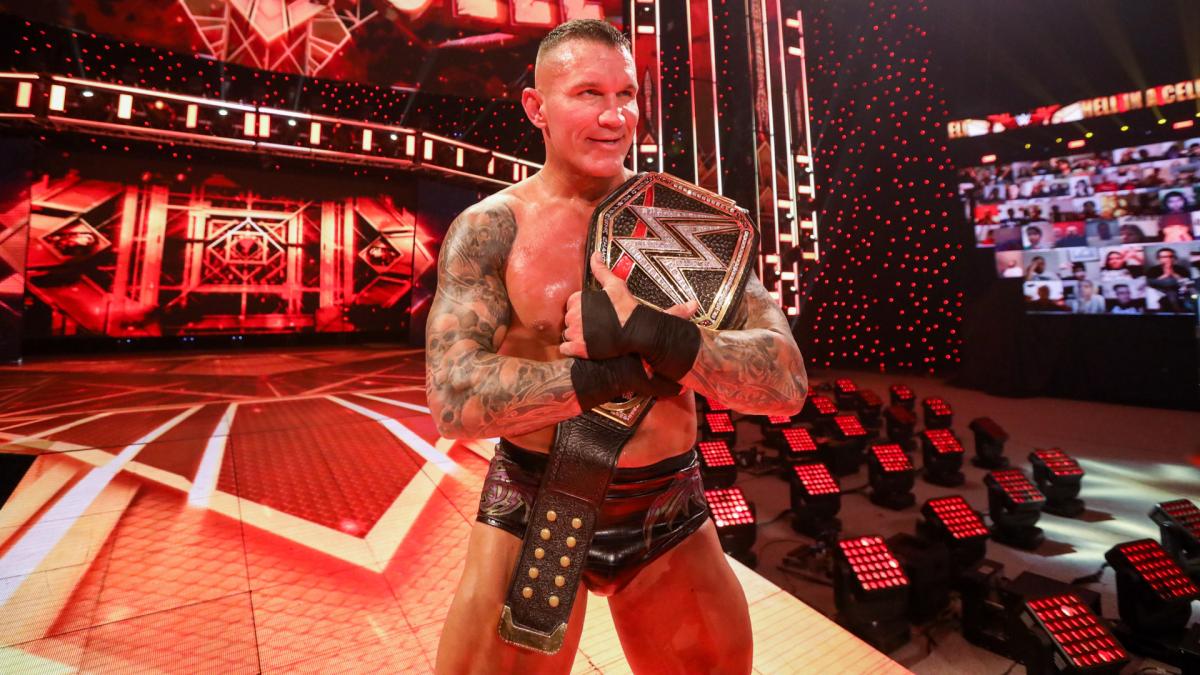
Randy Orton stops on the ramp after capturing his 14th WWE title. Photo courtesy of WWE.com
Bray Wyatt’s family legacy is staggered across both parents, much like the Rocks or Natalyas. Wyatt (and brother Bo)’s father is Mike Rotunda (also known as I….R…S…although this relationship is also kayfabe). His grandfather is Blackjack Mulligan, which makes Barry Windham his very successful former world champion uncle and Kendall Windham his other uncle who wrestled.
Wyatt is a fascinating case. Another product of WWE developmental who was signed to FCW out of university, he went through a series of name and gimmick changes including a knockoff Dukes of Hazzard tag team with his brothers, a hockey mask-wearing monster and the aforementioned Husky Harris. Like the other cases I mentioned, Husky Harris went nowhere. The best thing to happen to him was a punt by Randy Orton, which sent him back to FCW. This trip back down to the farm gave Wyatt the chance to reinvent himself and unleash the rabid creativity we still see today. To me, Wyatt is unique. His family connections are at best tacitly raised in WWE programming — most notably when he skipped a few shows following Blackjack Mulligan’s funeral, but his character is steeped in Southern — particularly Florida — wrestling history. From the initial cult leader Wyatt character with his Hawaiian shirts and affected mannerisms and looming henchmen, to the demonic presentation of the Fiend, to his current drawl and conflicted meditations and love of UV reflective face paint, he has taken the most gonzo parts of Dusty Rhodes and Kevin Sullivan and Dan Spivey and a host of others and made them something new.
He may be a sharper dresser, but the current version of Cody Rhodes sits right by Wyatt in honoring his father’s work. Barring copyright issues, Cody has always used the family name either directly or when interacting with his half-brother as Stardust. But Cody seems to want to have it both ways. He cites Dusty repeatedly and cuts similarly excited promos. He even dyed his hair platinum blonde like the American Dream but Rhodes is working hard to create his own image-an image that crosscuts his father’s work.
As a fan, I find it confusing. Rhodes has appropriated his father’s nickname and calls himself the American Nightmare. Dusty regularly appeared dressed in jeans and a t-shirt, reinforcing his ‘man of the people’ status. Occasionally he would show up in a ludicrous full-length fur coat or an ill-fitting suit. In his gear, he looked out of shape but moved with surprising speed and grace. He spoke plainly to his audience about the hard times they shared, pausing frequently for asthmatic breaths in a pattern he admittedly ‘borrowed’ from the Black community. That last part would be as tough a sell today as Roman Reigns eating a raw chicken on camera. But Cody dresses in a full suit and tie and dress shoes. He over-accessorizes with cufflinks and tiepins and watch chains (especially weird since he wears a wristwatch; he and Tony Khan bonded over them in AEW). His appearance is sculpted and his gear seems new every week. And when he speaks he is powerful, but not afraid to venture into the deeper regions of his vocabulary, pulling out polysyllabic words at will. WWE’s Cody feels like an extension of AEW’s Cody — and like that version it may only be a matter of time before the goodwill of his father’s name is overtaken by the fact that in word and deed, Cody is a brilliant natural heel.
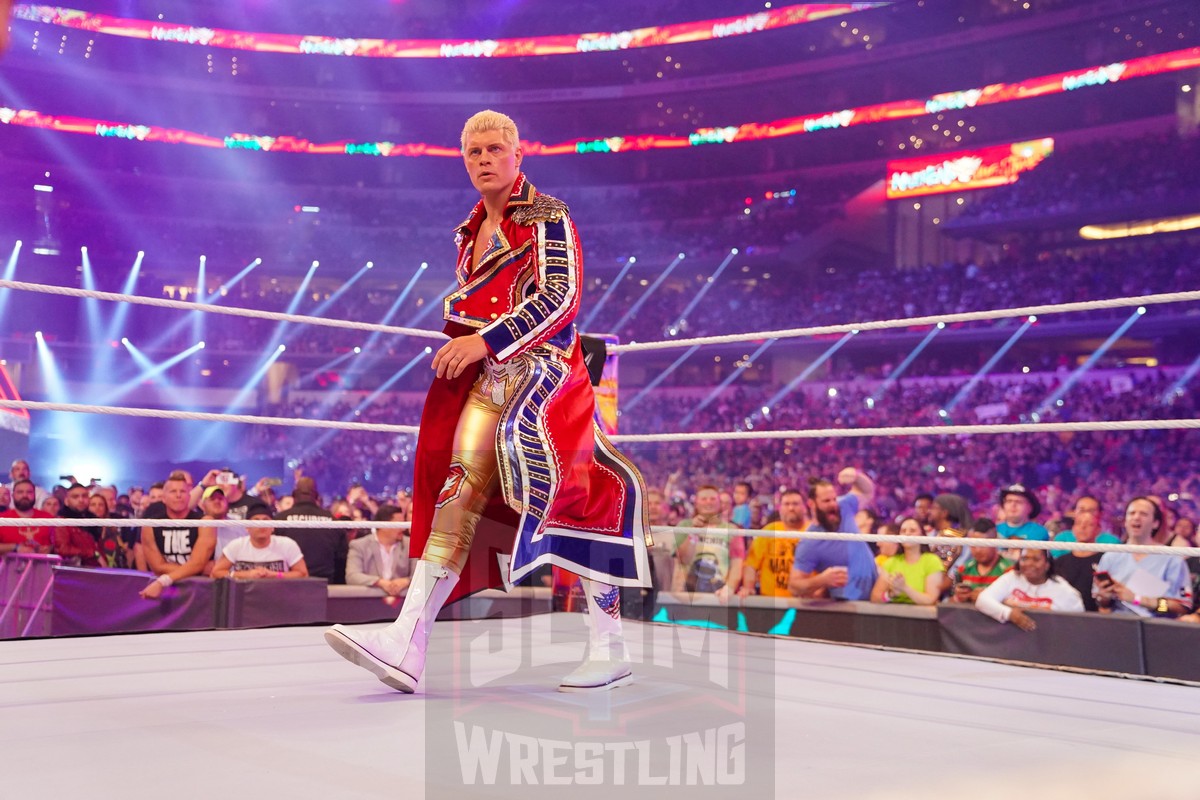
Cody Rhodes at WrestleMania 38 at AT & T Stadium in Arlington, Texas, on April 2, 2022. WWE photo
Maybe Cody learned from his older brother, Dustin. Dustin has had his own long, successful career and has survived an often-brutal industry to become a widely respected figure. He’s had a long hard trip. His first appearances gave every appearance of Gulas-style nepotism. He would flank his father in his feud with Ted DiBiase in the WWF and be pushed early and hard to tag team and US title runs in WCW. He was sold as a natural but he was really a high school kid — an awkward mix of gangly and doughy and without an identity beyond his dad’s. The fact that he spent his early years trailing after Dusty as the territories continued to dry up didn’t help.
Dustin might disagree but I think he came into his own as a performer when he was hired by Vince McMahon to play Goldust. Gone were the cowboy boots and 8-ball leather ring jackets and the southern accent. In their place were the gold bodysuit and facepaint and robes and music worthy of Dusty’s archrival Ric Flair (Cody’s current persona reads more like a combination of Nick Bockwinkel and Flair than anything Dusty ever did). A healthy dose of early 1990s homophobia would create a sharp break between his character and Dusty’s, and a semi-kayfabe interview with Jim Ross would set out how fractured his relationship with his father had become. Dustin would go on to more gimmick changes and face/heel turns and battle various addictions to get where he is today. He would also reconcile with his father and at some point figured out how to integrate his family name into his own character. He now brings a Western motif to the bodysuits and facepaint. In matches, he mixes his dad’s old “flip flop and fly” spot with flying hurricanranas and Canadian destroyers. It’s a shame he got to this point relatively late in his career, by the time he and Cody were teaming up against the Shield I felt he was putting on championship-worthy matches… but again, genes and experience can’t beat a promoter’s perception.
Which brings me to Cody’s WrestleMania opponent. The biggest star in wrestling right now is probably WWE Undisputed Universal Champion Roman Reigns. He is the latest champion to come out of the Anoa’i-Fatu dynasty. The Anoa’i family tree, while highly decorated, is complex and may rely on a broader definition of family that straddles culture and kayfabe. Actual brothers Afa and Sika are at the heart of the family. Wrestling lore incorporates the Maivia family (thus, Rocky Johnson, The Rock and now Ava Raine and Nia Jax), the Fifitas (Haku and his sons/nephews Tama Tonga, Tanga Loa, Hikuleo and more distantly Bad Luck Fale) and Jimmy Snuka and his wrestling progeny Deuce Shade and Tamina.
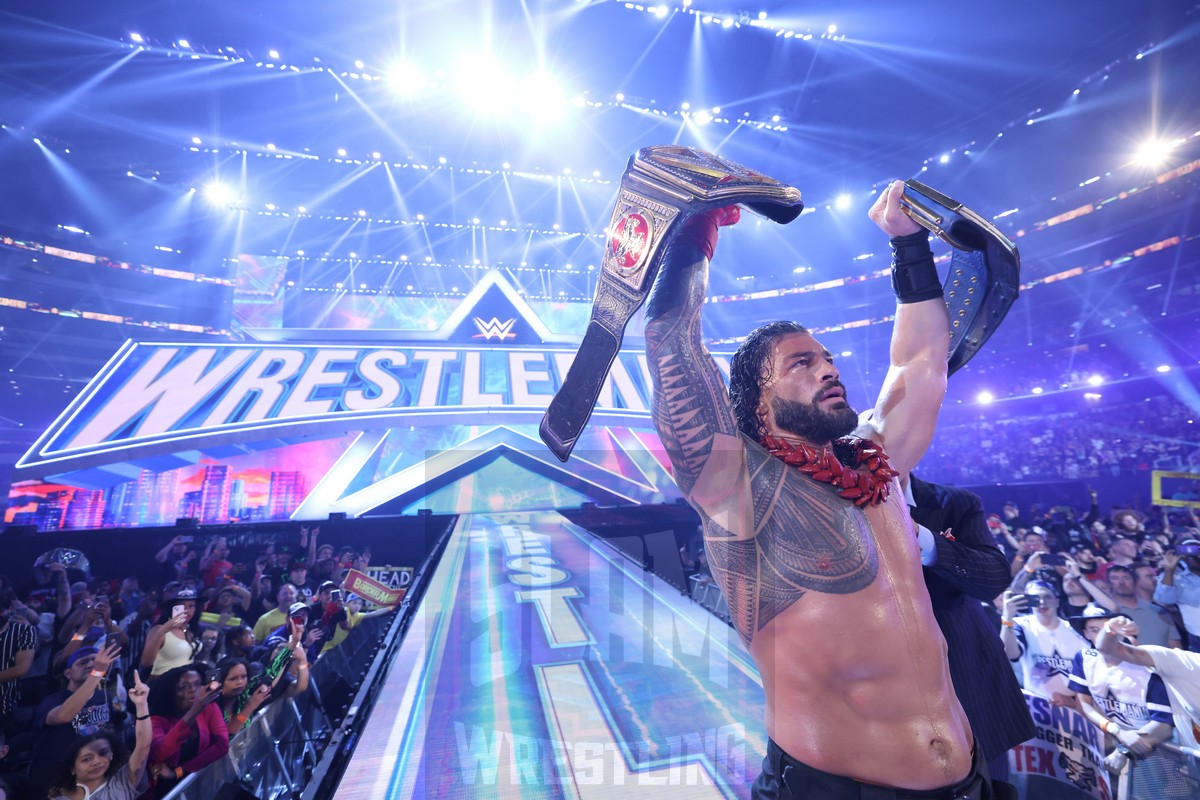
Roman Reigns is the Universal and WWE Champion after a Championship Unification Match at WrestleMania 38 at AT&T Stadium in Arlington, Texas, on Sunday, April 3, 2022. WWE photo
With so many kids entering the business, there’s bound to be a mix of more and less successful members. Afa and Sika were a hugely influential tag team worldwide. They also worked a “Samoan Wildman” gimmick that one might think would play poorly today… but it persisted through the next generation or two: Afa’s son Samu was brought into the act early to compensate for an injury. He would later team variously with his twin cousins Fatu and the Samoan Savage who would in turn do time as Rikishi (father of the current WWE tag team champions the Usos and Solo Sikoa) and the Tonga Kid. A pre-Yokozuna Rodney Anoa’i would work his uncles’ gimmick on the independent scene as Kokina Maximus well into the 1990s. Eddie Fatu — another cousin — would even play a similar role as Umaga in this century. Whispers of Umaga’s performance continue to echo through Solo Sikoa’s portrayal of a mostly mute enforcer.
In the 1990s the Anoa’i family transitioned from one potentially harmful stereotype to another. Over time the Wild Samoans have shifted to Organized Crime.
Another of Sika’s sons — Matthew — would initially team with Samu as the Samoan Gangster Party. They would surface briefly in the WWF feuding with (Rikishi) Fatu, who had transitioned to an urban motivational speaker gimmick with a dark past. Matt Anoa’i would reprise this gangster character in more casual clothing with a pre-Umaga cousin Eddie as Three Minute Warning.
The current Bloodline story began in earnest with Afa and Sika bestowing the mantle of leadership on Sika’s son Roman Reigns. The Usos would become his lieutenants, Paul Heyman (who has his own history having managed Samu, Fatu and the Samoan Savage in WCW) is his Tom Hagen-like consiglieri. Until he was booted out, Sami Zayn was the wannabe Uso, denied membership because his background didn’t fit. This pulls from a different movie-a ripoff of the plot of Goodfellas, wherein Ray Liotta’s and Robert DeNiro’s characters are denied ‘made guy’ status because they’re not full-blooded Italians.
The Anoa’i-Fatu dynasty likely isn’t done but starting from their parent’s/grandparent’s tag team success under a cancellable gimmick, it’s hard to think of a case where a single family of performers has so entrenched itself across generations in the top tier of pro wrestling.
All of which is to say, Happy Birthday Dad.
TOP PHOTO: The Bloodline. WWE photo
RELATED LINK
